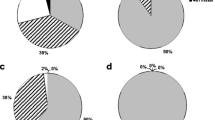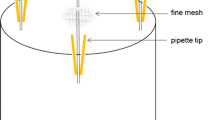Abstract
The limited availability of sugar sources (e.g., flowers) in greenhouses may affect biological pest control by parasitoid wasps. However, few studies have focused on feeding devices to provide parasitoids with sugar foods. We investigated the accessibility of a yellow-colored bottle-type feeding device to adult Cotesia vestalis (Halliday), a larval endoparasitoid of the diamondback moth Plutella xylostella (L.). All parasitoids died within four days in a room with no sugar source, whereas 66.7 % of individuals survived if a bottle-type feeding device providing honey solution was installed. We also investigated female longevity in response to different sugar solutions presented in a bottle-type feeding device. Honey and sugar mixtures (glucose and fructose) improved female longevity (38.4 and 39.2 days, respectively) much more than water (3.1 days), indicating these feeding devices containing sugar foods to be potentially useful for maintaining C. vestalis in greenhouses where natural food sources are limited.




Similar content being viewed by others

References
Abe J, Urano S, Nagasaka K, Takabayashi J (2007) Release ratio of Cotesia vestalis to diamondback moth larvae (Plutella xylostella) that suppresses the population growth of diamondback moth feeding Brassica leaf vegetables in a greenhouse. Bull NARC West Reg 6:125–132 (in Japanese with English summary)
Azzouz H, Giordanengo P, Wäckers FL, Kaiser L (2004) Effects of feeding frequency and sugar concentration on behavior and longevity of the adult aphid parasitoid: Aphidius ervi (Haliday) (Hymenoptera: Braconidae). Biol Control 31:445–452
Ben Saad AA, Bishop GW (1976) Effect of artificial honeydews on insect communities in potato fields. Environ Entomol 5:453–457
Bianchi FJJA, Wäckers FL (2008) Effects of flower attractiveness and nectar availability in field margins on biological control by parasitoids. Biol Control 46:400–408
Cortesero AM, Stapel JO, Lewis WJ (2000) Understanding and manipulating plant attributes to enhance biological control. Biol Control 17:35–49
Furlong MJ, Wright DJ, Dosdall LM (2013) Diamondback moth ecology and management: problems, progress, and prospects. Ann Rev Entomol 58:517–541
Harvey JA, Cloutier J, Visser B, Ellers J, Wäckers FL, Gols R (2012) The effect of different dietary sugars and honey on longevity and fecundity in two hyperparasitoid wasps. J Insect Physiol 58:816–823
Hirose Y, Mitsunaga T, Yano E, Goto C (2009) Effects of sugars on the longevity of adult females of Eretmocerus eremicus and Encarsia formosa (Hymenoptera: Aphelinidae), parasitoids of Bemisia tabaci and Trialeurodes vaporariorum (Hemiptera: Alyerodidae), as related to their honeydew feeding and host feeding. Appl Entomol Zool 44:175–181
Jacob HS, Evans EW (1998) Effects of sugar spray and aphid honeydew on field populations of the parasitoid Bathyplectes curculionis (Hymenoptera: Ichneumonidae). Environ Entomol 27:1563–1568
Kawaguchi M, Tanaka T (1999) Biological characteristics of a larval endoparasitoid, Cotesia plutellae (Hymenoptera: Braconidae): host stage preference, subsequent sex ratio of progeny and mate location of males. Appl Entomol Zool 34:213–221
Kugimiya S, Shimoda T, Mcneil JN, Takabayashi J (2010a) Females of Cotesia vestalis, a parasitoid of diamondback moth larvae, learn to recognise cues from aphid-infested plants to exploit honeydew. Ecol Entomol 35:538–541
Kugimiya S, Uefune M, Shimoda T, Takabayashi J (2010b) Orientation of the parasitic wasp, Cotesia vestalis (Haliday) (Hymenoptera: Braconidae), to visual and olfactory cues of field mustard flowers, Brassica rapa L. (Brassicaceae), to exploit food sources. Appl Entomol Zool 45:369–375
Landis DA, Wratten SD, Gurr GM (2000) Habitat management to conserve natural enemies of arthropod pests in agriculture. Ann Rev Entomol 45:175–201
Lewis WJ, Stapel JO, Cortesero AM, Takasu K (1998) Understanding how parasitoids balance food and host needs: importance to biological control. Biol Control 11:175–183
Lucchetta P, Bernstein C, Théry M, Lazzari C, Desouhant E (2008) Foraging and associative learning of visual signals in a parasitic wasp. Anim Cog 11:525–533
Meyhöfer R, Hindayana D (2000) Effects of intraguild predation on aphid parasitoid survival. Entomol Exp Appl 97:115–122
Mills NJ, Wajnberg E (2008) Optimal foraging behavior and efficient biological control methods. In: Wajnberg E, Bernstein C, van Alphen J (eds) Behavioral Ecology of insect Parasitoids. Blackwell, Oxford, UK, pp 3–30
Mitsunaga T, Shimoda T, Yano E (2004) Influence of food supply on longevity and parasitization ability of a larval endoparasitoid, Cotesia plutellae (Hymenoptera: Braconidae). Appl Entomol Zool 39:691–697
Mitsunaga T, Mukawa S, Shimoda T, Suzuki Y (2006) The influence of food supply on the parasitoid against Plutella xylostella L. (Lepidoptera: Yponomeutidae) on the longevity and fecundity of the pea leafminer, Chromatomyia horticola (Goureau) (Diptera: Agromyzidae). Appl Entomol Zool 41:277–285
Mitsunaga T, Shimoda T, Mukawa S, Kobori Y, Gotoh C, Suzuki Y, Yano E (2012) Color and height influence the effectiveness of an artificial feeding site for a larval endoparasitoid, Cotesia Vestalis (Haliday) (Hymenoptera: Braconidae). Jpn Agric Res Q 46:161–166
Romeis J, Städler E, Wäckers FL (2005) Nectar- and pollen-feeding by adult herbivorous insects. In: Wäckers FL, van Rijn PCJ, Bruin J (eds) Plant-provided food for carnivorous insects: a protective mutualism and its applications. Cambridge University Press, New York, USA, pp 178–219
Röse USR, Lewis J, Tumlinson JH (2006) Extrafloral nectar from cotton (Gossypium hirsutum) as a food source for parasitic wasps. Funct Ecol 20:67–74
Siekmann G, Tenhumberg B, Keller MA (2001) Feeding and survival in parasitic wasps: sugar concentration and timing matter. Oikos 95:425–430
Sokal RR, Rohlf FJ (1995) Biometry: the principles and practice of statistics in biological research, 3rd edn. W. H. Freeman and Company, New York, USA
Takasu K, Lewis WJ (1993) Host- and food-foraging of the parasitoid Microplitis croceipes: learning and physiological state effects. Biol Control 3:70–74
Talekar NS, Shelton AM (1993) Biology, ecology, and management of the diamondback moth. Ann Rev Entomol 38:275–301
Tang B, Xu L, Hou Y (2014) Effects of rearing conditions on the parasitism of Tetrastichus brontispae on its pupal host Octodonta nipae. BioControl. doi:10.1007/s10526-014-9600-0
Uefune M, Kugimiya S, Shimoda T, Takabayashi J (2013) Starvation and herbivore-induced plant volatiles affect the color preferences of parasitic wasps. BioControl 58:187–193
Wäckers FL (1994) The effect of food deprivation on the innate visual and olfactory preferences in the parasitoid Cotesia rubecula. J Insect Physiol 40:641–649
Wäckers FL (2001) A comparison of nectar- and honeydew sugars with respect to their utilization by the hymenopteran parasitoid Cotesia glomerata. J Insect Physiol 47:1077–1084
Wäckers FL, Lewis WJ (1994) Olfactory and visual learning and their combined influence on host site location by the parasitoid Microplitis croceipes (Cresson). Biol Control 4:105–112
Wäckers FL, Romeis J, van Rijn P (2007) Nectar and pollen feeding by insect herbivores and implications for multitrophic interactions. Ann Rev Entomol 52:301–323
Wäckers FL, van Rijn PCJ, Heimpel GE (2008) Honeydew as a food source for natural enemies: making the best of a bad meal? Biol Control 45:176–184
Wade MR, Zalucki MP, Wratten SD, Robinson KA (2008) Conservation biological control of arthropods using artificial food sprays: current status and future challenges. Biol Control 45:185–199
Winkler K, Wäckers FL, Stingli A, van Lenteren JC (2005) Plutella xylostella (diamondback moth) and its parasitoid Diadegma semiclausum show different gustatory and longevity responses to a range of nectar and honeydew sugars. Entomol Exp et Appl 115:187–192
Winkler K, Wäckers FL, Pinto DM (2009) Nectar-providing plants enhance the energetic state of herbivores as well as their parasitoids under field conditions. Ecol Entomol 34:221–227
Witting-Bissinger BE, Orr DB, Linker HM (2008) Effects of floral resources on fitness of the parasitoids Trichogramma exiguum (Hymenoptera: Trichogrammatidae) and Cotesia congregata (Hymenoptera: Braconidae). Biol Control 47:180–186
Acknowledgments
We thank Ms. Kimiko Kanbe, Ms. Yumiko Togashi and Ms. Yoshiko Ishimura for rearing the insects and growing the plants. This research was supported by the Bio-oriented Technology Research Advancement Institution and JSPS KAKENHI Grant Numbers (24780049 for SK, 19380188 and 22380038 for TS).
Author information
Authors and Affiliations
Corresponding author
Additional information
Handling Editor: Torsten Meiners.
Rights and permissions
About this article
Cite this article
Shimoda, T., Mitsunaga, T., Uefune, M. et al. A food-supply device for maintaining Cotesia vestalis, a larval parasitoid of the diamondback moth Plutella xylostella, in greenhouses. BioControl 59, 681–688 (2014). https://doi.org/10.1007/s10526-014-9611-x
Received:
Accepted:
Published:
Issue Date:
DOI: https://doi.org/10.1007/s10526-014-9611-x



